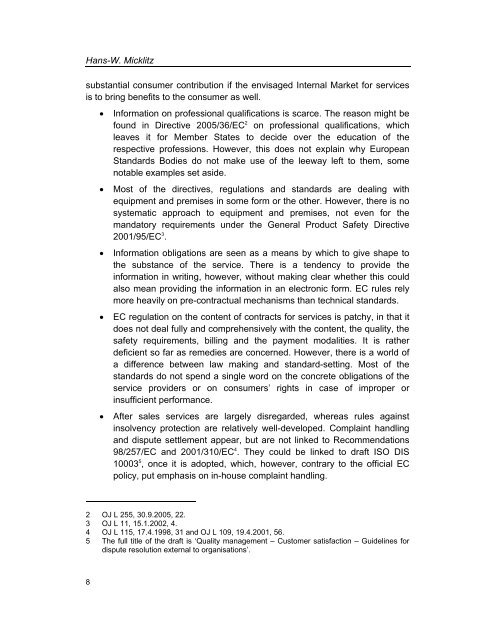Services Standards: Defining the Core Consumer Elements ... - ANEC
Services Standards: Defining the Core Consumer Elements ... - ANEC
Services Standards: Defining the Core Consumer Elements ... - ANEC
You also want an ePaper? Increase the reach of your titles
YUMPU automatically turns print PDFs into web optimized ePapers that Google loves.
Hans-W. Micklitz<br />
substantial consumer contribution if <strong>the</strong> envisaged Internal Market for services<br />
is to bring benefits to <strong>the</strong> consumer as well.<br />
• Information on professional qualifications is scarce. The reason might be<br />
found in Directive 2005/36/EC 2 on professional qualifications, which<br />
leaves it for Member States to decide over <strong>the</strong> education of <strong>the</strong><br />
respective professions. However, this does not explain why European<br />
<strong>Standards</strong> Bodies do not make use of <strong>the</strong> leeway left to <strong>the</strong>m, some<br />
notable examples set aside.<br />
• Most of <strong>the</strong> directives, regulations and standards are dealing with<br />
equipment and premises in some form or <strong>the</strong> o<strong>the</strong>r. However, <strong>the</strong>re is no<br />
systematic approach to equipment and premises, not even for <strong>the</strong><br />
mandatory requirements under <strong>the</strong> General Product Safety Directive<br />
2001/95/EC 3 .<br />
• Information obligations are seen as a means by which to give shape to<br />
<strong>the</strong> substance of <strong>the</strong> service. There is a tendency to provide <strong>the</strong><br />
information in writing, however, without making clear whe<strong>the</strong>r this could<br />
also mean providing <strong>the</strong> information in an electronic form. EC rules rely<br />
more heavily on pre-contractual mechanisms than technical standards.<br />
• EC regulation on <strong>the</strong> content of contracts for services is patchy, in that it<br />
does not deal fully and comprehensively with <strong>the</strong> content, <strong>the</strong> quality, <strong>the</strong><br />
safety requirements, billing and <strong>the</strong> payment modalities. It is ra<strong>the</strong>r<br />
deficient so far as remedies are concerned. However, <strong>the</strong>re is a world of<br />
a difference between law making and standard-setting. Most of <strong>the</strong><br />
standards do not spend a single word on <strong>the</strong> concrete obligations of <strong>the</strong><br />
service providers or on consumers’ rights in case of improper or<br />
insufficient performance.<br />
• After sales services are largely disregarded, whereas rules against<br />
insolvency protection are relatively well-developed. Complaint handling<br />
and dispute settlement appear, but are not linked to Recommendations<br />
98/257/EC and 2001/310/EC 4 . They could be linked to draft ISO DIS<br />
10003 5 , once it is adopted, which, however, contrary to <strong>the</strong> official EC<br />
policy, put emphasis on in-house complaint handling.<br />
2 OJ L 255, 30.9.2005, 22.<br />
3 OJ L 11, 15.1.2002, 4.<br />
4 OJ L 115, 17.4.1998, 31 and OJ L 109, 19.4.2001, 56.<br />
5 The full title of <strong>the</strong> draft is ‘Quality management – Customer satisfaction – Guidelines for<br />
dispute resolution external to organisations’.<br />
8
















